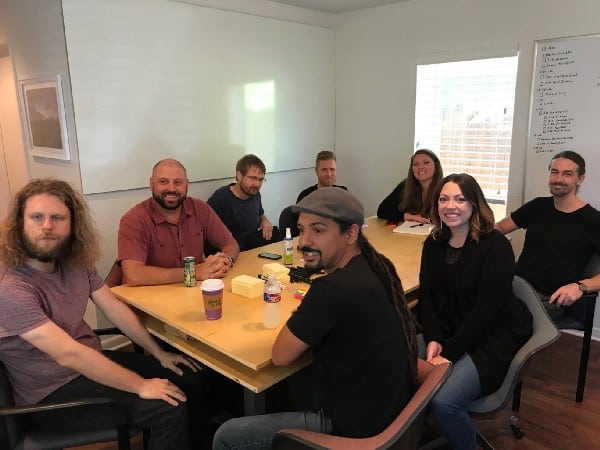Learn how we plan every Design Sprint and download our planning guide.
As with almost anything in life, planning is essential. Design Sprints are no exception. Design Sprints are a 5-Day process development by Jake Knapp who documented the process in his NYT bestselling book Sprint. With the Design Sprint method, Jake distilled Design Thinking into a simple and repeatable structure that anybody can follow. This simplicity is both helpful and problematic. Since Design Sprints present such great promise, the idea of doing one generates great excitement. This excitement, combined with an easy-to-follow structure, causes many people to dive in without the requisite thought and preparation. Don’t be one of them!

“By failing to prepare, you are preparing to fail.” ― Benjamin Franklin
This article is an extension of a prior post on Design Sprint planning tools and resources. In my previous post, I assembled some of my favorite links and assets so that you might more easily find them. In this post, I’ll provide a bit more structured guidance on the types of things you’ll want to consider as you embark on your Sprint. Whether it is your 1st Sprint or your 100th Sprint, you’ll want to keep these things in mind, so bookmark this page!
Figure Out Your “Why”
Just like the Sprint starts with the end in mind, so should your planning. While I don’t advocate that teams lock their goal in stone prior to the Sprint, it is helpful to explore the Goal and have a thoughtful perspective on where you’re generally pointed. The last thing you want is to begin the goal exercise on Day 1 with everyone staring at you like deers blinded by headlights. Start off your Sprint with a solid understanding of the purpose and how that fits into your company’s vision.
TOOLS TO CONSIDER
Liberating Structures is an effective set of methods that are great for planning and aligning stakeholders. If you are struggling with planning, Purpose to Practice (P2P) is a simple-and-rigorous method that you can use to layout the essential elements of your Sprint. This tool works well for both small groups and extremely large groups and is an excellent tool for building alignment early in your process. After using P2P for a few different projects, it will become an everyday method you can use to do anything from planning staff meetings to outlining key elements of your next product design process.

Within each element of P2P, you can use different methods to get at your answers — or you can simply invite your stakeholders to assist by asking core questions for each element. Below are a few things to consider for each element.
- Purpose: For many teams, purpose is elusive or at least not a daily topic of conversation. There are a few Liberating Structures (LS) that are well suited for helping you articulate your purpose. 9 whys, TRIZ, 1–2–4-All, and 25/10 are great places to start.
- Principles: If you find it challenging to define or agree on your principles, check out these LS activities: Appreciative Interviews, TRIZ, and Min Specs are effective tools for teasing the details from your team.
- Participants: Select your facilitator, decider, and other key roles. Consider who is missing.
- Structure: Think about how you will document the Sprint, prepare for your kickoff meeting, schedule a space, and order coffee/food.
- Practices: Consider pre-work like: upfront research, unanswered questions, and lack of clarity.
“Who” Matters
I hear from folks all the time who are struggling with who to invite to their Design Sprint. Worst of all are those people who don’t even realize it is such a critical concern and simply invite their peers. If you do not include a diverse set of stakeholders across all the functions of your organization, then there is considerable risk that your project will falter.

Lucky Number Seven
You must limit the number of attendees in the Design Sprint to seven people. For every person you include above seven, you increase the risk of generating so much content that you can’t stay on time and devolving in to an uncontrolled conversation that is difficult to steer. Everyone won’t be heard and it’s difficult to break into small groups. More is not more.
The Sprint book recommends that you include someone who understands the customer, the financials, the messaging, the logistics, and prototyping. You should always remember to include someone who can ensure the project will have support post-Sprint. Within the Purpose to Practice framework, the key question one asks when looking at Participants is: “who must we include to meet our purpose?” Another question I find helpful, which I learned as part of my Liberating Structures learning, is deceptively simple: “who’s missing?”
Strike a Balance
Don’t forget to account for the mindset or attitude of the attendees. It is important to strike a balance. While you want to cultivate an environment conducive to collaboration, you don’t want to avoid the skeptics and cynics either. It is not about seniority or stroking egos, it’s about different points of view and people who will really be able to engage and bring an open mind.
For large organizations, consider tools within the Liberating Structures repertoire to determine who should be in the room. 25/10 Crowd Sourcing can be used to generate ideas from a large group and could be used with either “who must be included to meet our purpose” or “who’s missing” from the discussion thus far. Social Network Webbing, TRIZ, and Discovery and Action Dialogue all have the potential to generate great ideas for composing your sprint participants.

Invite Others In
An excellent way to involve more people in the process without going over the 7 person limit is to bring them in on Monday as an expert or invite them to a daily readout. I’m a big fan of the daily readout as it exposes more of the team to the process and the progress that is being made.
Figure Out Recruiting
You should also have a solid game plan for how you will recruit your testers and who will be in charge of running the interviews. Sometimes I recommend starting your recruit beforehand, but most of the time you can do it during the week. Make sure that your test moderator is skilled at interviewing, knows how to put together a discussion guide, and has an unbiased approach.

Prepping Participants
Always take the time to educate your participants. Most of them will not have heard of Sprints, much less read the book. Even ones who have read the book may have missed parts. It’s important to set expectations. I recommend having a 30-minute kick-off meeting about 1 week prior to the Sprint. This is an opportunity to set expectations with the team and agree on any last-minute items that need to be addressed before your Sprint.
“What” You’ll Need
Do not wait till the last minute and buy whatever your local office supply store happens to have in stock. Jake carefully selected the supplies he recommends based on running hundreds of Sprints and they really do provide better results.
Don’t Skimp on Supplies

You can follow my supplies post to make sure you get all the correct items. Unfortunately, Amazon doesn’t have good support for a bill of materials, but I have put links on each of the supplies so you can make sure to get the correct items.

Two common mistakes to avoid are the pop-up Post-Its since the sticky side alternates from top to bottom and the Avery dots as they are difficult to remove from surfaces. If you do decide to get the Avery dots, you should also consider getting a putty knife.
I also like to include a pair of scissors, a Bluetooth speaker with a playlist, 3M flip charts, and a set of Tibetan chimes as sometimes the time timer alarm wears out its welcome.

Brain Food
Design Sprints are deep and intense work. This work requires that our body and mind are functioning at their best. Don’t short circuit your progress by bringing in unhealthy snacks and comfort food. This is tempting for some as they consider these treats a benefit or reward for this special event. Don’t fall prey to that trap. Bring in healthy food that’s high in protein and low in sugar. Nuts, fruit, protein bars, and vegetables are a great place to start.
Also, order delivery for lunch. Going out to lunch with a group this large always takes too long and disrupts your schedule. Also, the team will need time for bathroom breaks, checking email, etc.
“Where” is Critical
Space is critical. I’ve participated in enough Design Sprints in inadequate spaces that I make it a priority to discuss the venue in detail prior to starting the Sprint. There are some great pointers in this article on the pitfalls of facilitation.
You’ll want to have ample room to move around. Consider the fact that you’ll be hanging things on the wall and organizing them as a group. With all attendees in the room, can you comfortably cluster around the walls and still easily move from one side to the other?

Are the plenty of whiteboards? You will write up the goal, the questions, and the map, so you’ll need 2 large or 3 medium whiteboards. The smaller 2′ x 3′ whiteboards aren’t recommended.
Consider the location. Is there natural light and is the environment free of obnoxious sounds and odors? Ensure that there are minimal distractions. For some companies, working off-site might be helpful to get people out of their typical mindset. A change of scenery can be helpful for some companies, especially in environments entrenched in the status quo.
Have you also scheduled time to review? Did you schedule a room to conduct your interviews? Will they be in person? You may also need to consider how you will connect the two rooms for observation.
“How” to End Your Sprint
Reflecting on your Design Sprint after is important. If you are uncertain about how to best conduct your retrospective, consider the Liberating Structure, What, So What, Now What. WWW is well suited for synthesizing your Design Sprint insights because it supports you in building a discipline of reflection and action.
The more you and your team build a reflection-and-action habit, the more capable you become at adjusting in real-time, together. It also helps reduce unproductive conflict and makes space for people to get a sense of what others are oriented to before jumping to action, which is helpful when you are trying to make progress quickly and who don’t want to have to backtrack.
I hope that these tools are as effective for you as they are for me. If you have any questions or have found other approaches that work, I’d love to hear from you.
Want to find out more about planning a Design Sprint? Check out Design Sprint Resources & Planning Tools next!



